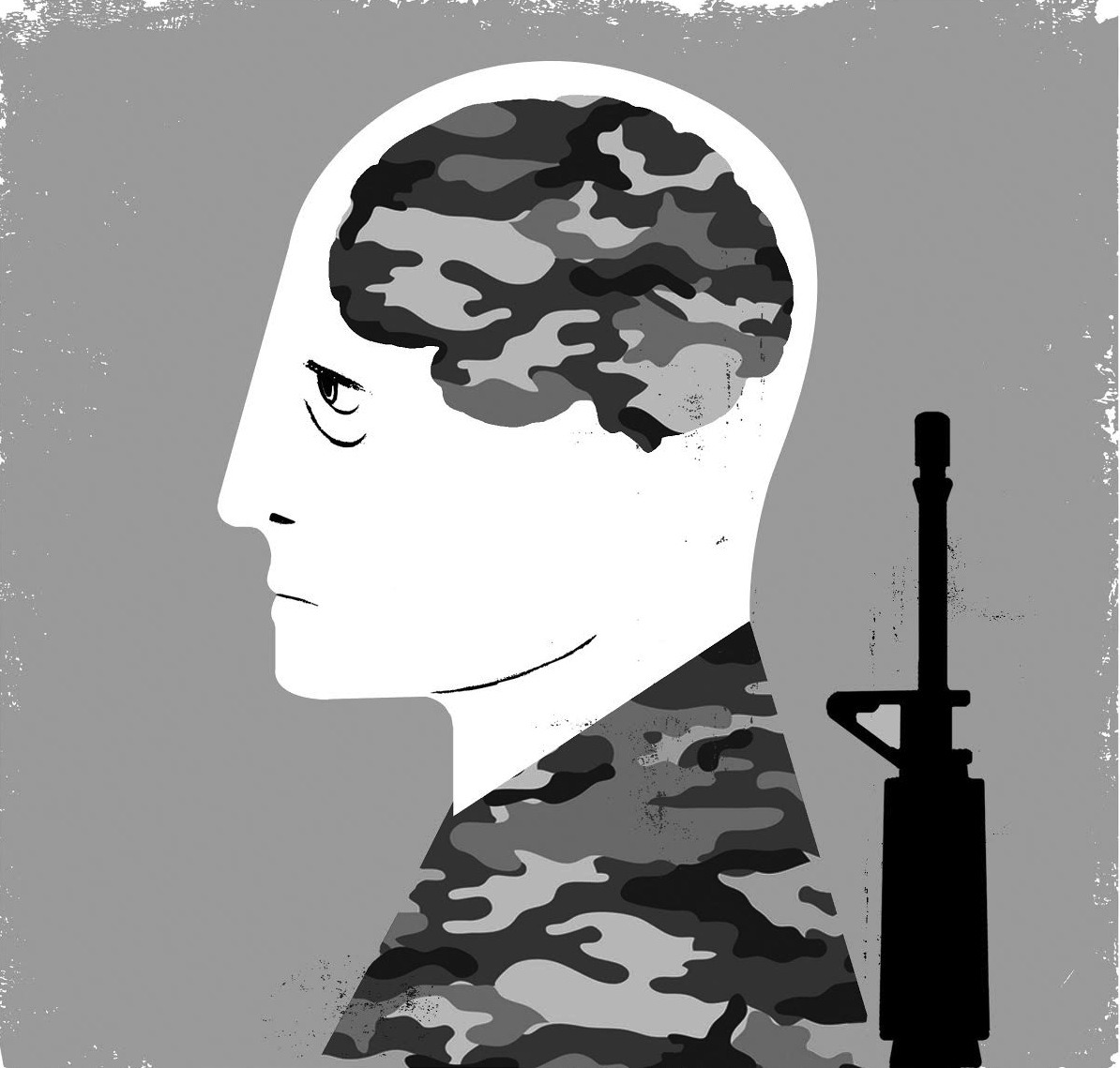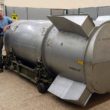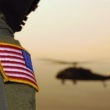Some cover-ups are scandalous. Others, like those surrounding the First Gulf War, suggest an official callousness that shocks and awes.
During and immediately after the war, 200,000 of 700,000 U.S. troops were exposed to nerve gas and other chemical agents. The Department of Defense (DOD), fully aware of the chemical hazards and the troop exposure, deployed a litany of lies. After this, it concocted a cover-up. That cover-up continues to this day.
Don Riegle, the senator who presided over Senate committee hearings in 1993-1994 about the veterans’ illnesses, recently told me: “Every effort was made for years to hide the truth and deny the medical research needed to fully treat the U.S. troops suffering from Gulf War Syndrome.”
Sirens wailed daily, but officers in charge said the chemical-detection alarms were faulty. They were not.
Today, troops who were closest to explosions are dying of brain cancer at two to three times the rate of those who were farther away. Others have lung cancer or debilitating chronic diseases. Now in their 40s, many struggle with irrevocable decline and persistent pain.
At a 1997 Congressional hearing, Reserve Navy Captain Julia Dyckman, a registered nurse and Gulf War veteran, said:
“You might ask what it is like to be a Gulf War veteran after six years … When you eat you are constantly sick and have intermittent diarrhea. Mobility is difficult due to swollen joints and muscle aches. Severe headaches are intermittent. Sometimes you forget what you are doing and what you were going to do. Pain and fatigue are constant companions. You are forced to deal with constant denials from the Pentagon that ‘nothing happened’ during the war. These statements confuse medical providers who then doubt your credibility … the VA says this illness ‘doesn’t exist’ or is ‘all in your head,'”
According to Linda Chao, a neurologist with the Veterans Administration (VA) and University of California Medical School who studies Gulf War illnesses, exposed veterans have brain damage. “Part of their brains, the hippocampus, has shrunk. This means they’re at greater risk for Alzheimer’s and other degenerative diseases.”
Moreover, a 2009 Georgetown University study found that the Gulf War veterans’ brain damage was similar to that of survivors of the 1995 sarin attack in Tokyo.
Many exposed veterans are today shadows of their once-tough 18- and 20-year-old selves. Worse, because the DOD continues to insist most weren’t exposed to high enough doses of sarin to cause health problems, 80 percent have been denied full disability compensation.
Last year, President Barack Obama appointed a new VA head, Secretary Robert McDonald, to fix “problems that have outraged us.”
The DOD and CIA have tried to bury documents for 25 years, revealing an unending pattern of deception, which was repeated with the 2003-2011 Iraq veterans exposed to nerve gas.
Lie No.1: “No information … indicates that chemical or biological weapons were used in the Persian Gulf,” wrote Secretary of Defense William Perry and Chairman of the Joint Chiefs John Shalikashvili, in a 1994 memo to about 20,000 Desert Storm veterans.
Strictly speaking, they were right: No weapons were used.
The sarin was fallout from U.S. military bombing or blowing up Iraq’s vast weapons sites.
The DOD knew it.
As Alan Friedman wrote in his 1993 book, The Spider’s Web: The Secret History of How the White House Illegally Armed Iraq, the Reagan and Bush administrations, which backed Iraq in its 1980-1988 war with Iran, approved U.S. sales of chemical technology to Iraq, including “a huge petrochemicals complex called PC2. More significant, Western intelligence knew that PC2 … would be dual use. This meant it could generate chemical compounds to make mustard and nerve gas.”
Riegle told me: “The decision by the Reagan-Bush Administration to secretly help Saddam Hussein build his biological and chemical weapons was a monstrous strategic error that eventually led to the tragedy of Gulf War Syndrome, which killed and disabled so many unprotected American troops.”
Lie No. 2: Alarms, which blared day after day from the chemical-detection equipment, were “false.”
When the U.S. bombed Iraq’s weapons sites, vast poisonous plumes floated as far as 50 kilometers across the desert to the Saudi Arabian border where thousands of U.S. and coalition troops were based. Sirens wailed, but officers told troops to remove batteries and ditch the alarms.
This remained the official story throughout the 1990s. DOD experts at Presidential Advisory Committee hearings in 1997 were adamant. According to Marine Corps Lieutenant Commander Art Nalls, “detections were at very low levels and in the mind of the analysts … indicative of a false alarm.”
They were not false.
Based on a declassified U.S. Central Command log, a Czech chemical-weapons detection unit found “trace concentrations of sarin, a nerve-paralyzing substance” drifting into Saudi Arabia during the U.S. bombings. French, British and U.S. intelligence units found similar evidence. Although the U.S. command was informed, the information was ignored.
Private Tracy Elledge, a combat engineer in Alpha Company, told me: “The alarms went off all the time. Our officers told us they were false. Not to worry.”
But they were breathing poison.
In a 2012 article in Neuroepidemiology, Jim Tuite, a Gulf War illness expert, and Robert Haley, an internist/epidemiologist at the University of Texas Southwestern Medical Center, wrote that, “Large numbers of U.S. and coalition military personnel were exposed to levels of sarin … high enough to cause irreversible or other serious, long-lasting adverse health effects.”
Lie No. 3: The munitions bunkers 15,000 troops were sent to demolish in March 1991 didn’t have chemical weapons.
Elledge, part of the team setting the C-4 plastic explosives at Khamisiyah, one of Iraq’s largest weapons sites, said because officers never told them about the aging rockets filled with sarin, “we didn’t wear our MOPP gear, the suits designed to protect us from chemicals. They said we wouldn’t need it. We placed the timed fuses, which gave us 10 minutes to get a half mile away. When the fuses went off, it looked like a huge mushroom cloud.
“I knew something was wrong right away, because the tape I wore on my jacket and around my trouser leg, which detects chemicals, turned purple. I showed my squad leader and he told me, ‘It’s nothing. It happened, because diesel spilled on you.’ I think he believed this. But I didn’t have any diesel in the bunker. In spite of this, a few minutes later we were sent back, through the smoke, to make sure we got everything.”
The squad leader might have been uninformed, but the higher-ups knew.
Jim Bunker, now the Executive Director of the National Gulf War Resource Center (NGWRC), was a lieutenant with the First Infantry Division. He trained as a demolition expert.
“Before the DOD blew up the weapons, it sent some papers with clear markings to the battalion officers and intelligence people to help them identify the chemical weapons. Then on March 2 or 3, the DOD sent in the ordnance disposal team to verify which chemicals were there. We don’t know what they found, because once the troops started blowing them up and people started getting sick, the reports disappeared. And they’re still missing. But all you have to do is connect the dots.”
Elledge insists the DOD knew about the chemicals.
“Before we went back to Saudi Arabia, we were told to dig a big pit, take off our uniforms, and burn them,” he said. “If they didn’t think they were covered with chemicals, why would they order us to do this?”
Next, the DOD developed a denial strategy: Nerve gas news was off the table.
It’s the cover-up that bothers Bunker the most—“hiding what happened, when the evidence is so clear.” But, he adds, “The DOD doesn’t ever want to take responsibility.”
When troops first got sick, Bunker said, his battalion commander, Col. John Gingrich, radioed headquarters to find out what was happening. He was told, “It’s the heat.”
He and Gingrich were furious.
“We knew this wasn’t true. It was only 85 degrees, and we’d trained in over 100 degrees—without people getting sick like this.”
The next day, the division commander Maj. General Thomas Rhame and Col. Michael Dodson came to their base.
“They told Gingrich to be quiet about the men’s symptoms,” Bunker said. “That ended it.”
Dodson, now head of the Armed Services YMCA, did not respond to calls.
Rhame, who is retired and until recently was vice president of the Association of the U.S. Army, told me:
“I don’t deny the troops were ill. But I don’t remember that incident and it’s not in my nature to tell a subordinate not to admit something because it might embarrass us.”
Gingrich told me he remembers the issue about the heat, but not that Rhame and Dodson visited the next day.
What does Bunker think?
“There’s no way for people to admit what really happened to us.”
“There’s no way for people to admit to what really happened to us.”
Ron Brown, a soldier with the 82nd Division, watched demolitions from a mile away.
“Within 15 minutes, I couldn’t breathe and my head was about to split open. Soldiers were nauseated, dizzy and had diarrhea, tight chests, and muscle spasms. About 30 of us went to the medic. He gave us Motrin and told us to drink water,” Brown said.
Bunker, who suffered even more severe symptoms, said he almost died.
When the U.S. started blowing up weapons in early March, his muscles twitched and cramped. But, he says, “This was nothing compared to what happened to me while the demolitions continued on March 28. First, I couldn’t control my muscles. But in a couple days, I had convulsions and collapsed. After this, they medevacked me to hospitals in Saudi Arabia and Germany, and then to the U.S.”
Bunker is now 100 percent disabled. This means “your disability prevents you from your full capable earning power for your educational level.”
Brown and Bunker say none of the soldiers knew what was happening. The DOD, the CIA and VA hid the truth as long as possible.
But the facts were irrefutable.
On March 23, 1991, the ARCENT NBC (Army Central Command Nuclear, Biological and Chemical staff) sent a secret (now declassified) memo to the XVIII Airborne Corps. It said:
“ARCENT has positive confirmation (by urinalysis) of cml (chemical) agent blister casualty in VII corps. We are not to bring this up to the press. If press asks, XVIII abn (airborne) Corps has had no cml (chemical) casualties.”
In October 1991, UNSCOM (the United Nations Special Commission) inspectors found nerve gas in the remains of rockets the U.S. blew up in Khamisiyah and alerted the Pentagon.
Although the Joint Chiefs briefed the CIA, other intelligence agencies and the White House about the UNSCOM finding early in November, no action was taken. Six years later, the DOD de-classified the UNSCOM memo, posting it on its Gulflink website. Seven months after that, the CIA had it removed—claiming the records revealed too much about the methods the CIA used to gather intelligence.
When news reports appeared in 1992-1993 about the Desert Storm veterans’ “mystery illnesses,” the DOD said problems were psychological.
Elledge says, “If I had 50 cents for every time a VA doctor told me my problems were in my head, I’d be a millionaire.”
When DOD and CIA witnesses at Riegle’s Senate hearings finally admitted UNSCOM inspectors had found traces of nerve gass at Khamisiyah, the DOD still insisted it “could not confirm that any US troops were at the site” and had no reports of any “soldier or civilian experiencing symptoms consistent with chemical warfare agent exposure.”
Also, the witnesses claimed the plumes were too small to reach the troops.
Patrick Eddington, a CIA analyst from 1994-95, who wrote Gassed in the Gulf, said in an interview that the agency “either ignored the reports, obfuscated or lied.” The CIA argued that, “Since no troops died immediately, this proved the weapons didn’t contain nerve gas.”
But Eddington explained that while, “high levels of nerve gas do kill immediately and no troops died right away, the DOD and CIA knew that even small amounts cause neurological damage. They knew this, because the DOD researched the effects of chemical weapons on primates at the Armstrong Labs in Texas in 1989-1990.”
Moreover, Congressional hearings in the mid-1990s revealed that many other researchers concluded this as far back as the 1980s.
When Eddington and his wife Robin, also a CIA analyst, pursued the issue for two years, their superiors stonewalled. They resigned in 1995.
Others were fired or also resigned.
According to a 1997 Committee of the Whole House report, “Gulf War Veterans’ Illnesses: VA, DOD Continue to Resist Strong Evidence Linking Toxic Causes to Chronic Health Effects,” Dr. Jonathan Tucker, a chemical weapons expert and policy analyst with the Presidential Advisory Commission on Gulf War Veterans’ Illnesses, testified at the Government Reform and Oversight hearings that the veterans were sick, because they were exposed to nerve gas or other chemical agents.
He added that, “Gulf War illness has also been reported among Australian, British, Canadian, Czech, Hungarian, Kuwaiti, New Zealander, and Norwegian veterans.”
For his efforts, he was given one hour to pack up and leave the Advisory Committee in December 1995.
Declassified Army memo: “ARCENT has positive confirmation (by urinalysis) of cml (chemical) agent blister casualty in VII corps. We are not to bring this up to the press. If press asks, XVIII abn (airborne) Corps has had no cml (chemical) casualties.”
Also sacked was Dr. Asaf Durakovic, a medical unit commander during the war and chief of nuclear medicine at the VA Medical Center in Delaware. He testified at the hearings that he was fired, because of his “outspoken views” on the VA’s treatment of sick Gulf War veterans.
In late 1991, he said, when 24 sick veterans were referred to him, “Preliminary tests showed 14 of the 24 contained decay products of radioactive uranium.” But when he sent their urine samples to the Army Radiochemistry Lab in Maryland, the samples disappeared. By 1997, two of the 14 veterans had died.
“I faced every conceivable roadblock when I tried to analyze and treat the patients. I was ridiculed. My plan failed, because of total lack of interest on the part of the VA to do anything for those unfortunate patients,” he testified at the hearings.
Captain Julia Dyckman suffered on two fronts—both as a health care provider and patient.
At the same hearings, Dyckman testified that she was based at a combat hospital in Saudi Arabia where she treated troops with respiratory problems, unexplained fevers and stomach pains, vomiting, diarrhea, rashes, reactions to immunizations, and cardiac problems.
Once back in the U.S., she interviewed sick troops.
“The Readiness Commander did not like the results of my interviews … interfered with my medical care … [and] … records of interviews I conducted were discarded.”
Soon, she too became sick.
“I was released from active duty … offered Tylenol and told, ‘Nothing is wrong with you, get it through your head!’ For over 2-1/2 years, I was shuffled from one VA clinic to another.’”
Why must the DOD, CIA and VA lie?
“If you’re DOD, you’re admitting your policies contributed to the veterans’ illnesses. If you’re the VA, you’re admitting you don’t know how to treat the vets. If you’re the CIA, you blew another estimate and that’s not something you want on your resume,” Eddington explained.
Furthermore, the U.S. would have to admit it sold Iraq many of the chemicals in the 1980s, during its war with Iran. The same ones that sickened the U.S. troops.
By 1996, when UNSCOM went public about the nerve gas its inspectors found at Khamisiyah, DOD and CIA credibility was compromised. Also, Eddington had seen classified intelligence that the CIA knew chemical weapons were detected, and he and his wife were pushing the agency to come clean. Furthermore, the Riegle hearings, along with hearings held by then-Rep. Chris Shays, addressed the VA’s failure to give veterans proper care.
In 1997, the DOD wrote some veterans, finally admitting U.S. troops did destroy chemical weapons at Khamisiyah, that nerve gas was released, and that troops “may have been exposed.”
But even then it insisted that “exposure levels were too low to activate chemical alarms or cause any symptoms” … and that “current medical evidence is that long-term health problems are unlikely.”
The CIA also chimed in. In a 1997 report, it stated that it didn’t “recognize” the “possible chemical weapons storage at Khamisiyah … until early 1996, during a review of the facility.”
It also insisted that on March 10-11, during the Khamisiyah demolitions, “The troops that performed the demolitions had evacuated the area. We know of one (italics added) that drove briefly through the smoke from the explosion. He had no ill health effects.”
Today, Brown is incredulous.
“How could they say no one was sick? So many of us were lining up to be treated.”
Bunker adds that in the mid-1990s, the President’s Research Advisory Commission investigating Gulf War Illness produced a chart listing which troops were sick (assigning them letters, such as ‘Veterans A to Z’), when they were treated, where they were located (in the desert or elsewhere), if they were under the plume, and their symptoms.
As the controversy continued, the DOD and CIA announced in 1997 they would do field tests in Dugway Proving Ground, Utah, to learn more about the strength of the nerve gas, size and height of the plume, which troops were exposed, and where they were located.
The Government Accountability Office (GAO) reviewed test results and reported in 2004 that the agencies may have “dramatically underestimated” the size of the plume, the strength of the nerve gas, and number of troops exposed.
Furthermore, it claimed the study didn’t “capture the vets’ chronic illnesses,” because it only checked the hospitalizations … and “the types of chronic illnesses the Gulf War veterans report, typically do not lead to hospitalizations.”
Not surprisingly, the DOD responded that it “disputed most of the GAO report.”
Ditto for the CIA, which “did not concur … indicating it could not complete a review in the time allotted,” which, it wrote, would take “three or four weeks.”
From the time the DOD admitted troops may have been exposed, it constantly re-tallied the toll: In 1996, there were 300-400; from 1997 to 2002, up to 5,000, 20,000, 99,000 and finally 101,752. Still, it claimed they were only exposed to “very low levels of nerve gas agents.”
Brown said it is hard for veterans to prove their illnesses are “service-connected” because they can’t get their medical records. When he and others tried to obtain them, they learned the records disappeared. In a 2007 letter, Dr. Gary Trogdan, chief of the Public Inquiries Section at the Army’s Historical Resources Branch, wrote one veteran that Army units were told to destroy the “after action” reports, since “there was no space to ship the paper back to the States.”
Brown, who suffers from joint and muscle pains, migraines, chronic sinusitis and respiratory disease, was finally rated 100 percent disabled in 2010. But it took him 13 years to get it approved.
Bunker insists the veterans don’t even need their records. “If they are diagnosed with fibromyalgia or had chronic diarrhea for the past four or five years, it’s considered service-connected. It’s presumptive under the law for Gulf War veterans—even if they can’t diagnose the cause. But the VA still denies veterans’ claims because they don’t have their medical records.”
He adds that “12 years ago, the VA Inspector General admitted that 30 percent of the claims being denied were due to VA examiners’ errors. Nevertheless, the VA hasn’t held the regional offices accountable.”
However, Bunker is optimistic, since he notes that Secretary McDonald recently formed groups to see if certain illnesses should be re-classified as presumptive and to present their findings this spring. Also, McDonald has asked for two other studies to be completed by 2016 and 2017.
Furthermore, Brown recently spoke with McDonald—after trying unsuccessfully to reach the previous secretary for four months.
He says, “McDonald seems interested.”
Just last month, McDonald wrote him, saying he was extending the date for veterans to file for presumptive service-connected disability claims.
Still, when Brown read a 2014 New York Times article about the 600 U.S. troops exposed to chemical weapons in Iraq from 2003-2011, he called the hotline and was told it was only for the newly exposed veterans. When he complained, he was told to call an Aberdeen Proving Ground program. There, the researcher, Colleen Baird, told him she could only handle 50 veterans.
He asked Baird what she could do for the 200,000 Gulf War veterans who are very sick. She said she’d refer this to another office.
When Brown read a March 27, 2015 New York Times article that said the Army was apologizing to the 600 Iraq War veterans, he was furious.
“I felt betrayed. I’m happy for the 600. But this is a kick in the gut to the Desert Storm vets. There are 200,000 of us who were exposed to the exact same chemicals in 1991, and are sick and dying,” he said.
Then there are the veterans’ families.
At the Riegle hearings, the veterans’ wives said they had serious health problems, as did their children, many of whom had genetic defects.
Until now, little if any research has been done on this.
Not surprisingly, nothing is known about the chemicals’ neuro-toxic effects on Iraqis.
Barbara Koeppel is an investigative reporter in Washington, D.C.







I would really very much like to speak with Ms. Koeppel. I directed a National Institute of Health Research Center focused on understanding the mechanism of toxicity and attempts to identify therapeutics to treat the effects of Sulfur Mustard, the most commonly used blister agent. I am very disappointed that these exposed individuals where hid from those of us working to treat their serious disorders caused by exposure.
Dr. Grotendorst,
I can be reached care of the Spectator’s managing editor. Please send an email message with contact information to [email protected].
Barbara
This article has some useful information it also unfortunately has some mis information in it as well. It implies that out 700,000 veterans 200,000 are sick and this occurred only from chemical exposure that gas cloud floated throughout the Middle East making allied troops sick. Troops got sick in Red sea on ships, they got sick from Saudi to Turkey. Statistically speaking if minute particles of gas spread through out Middle East we should be selling millions of cases of Gulf War Illness in the civilian population. Not few hundred cases of DU exposed Iraqi’s. How would I know this Desert Storm veterans who served on a submarine in Desert storm. Who has rare blood enzyme condition vulnerable to chemicals, chemical weapons, as well as anthrax vaccine. This article does nothing to address the veterans that got sick during desert shield as well long before any chemical weapons exposure might have happened. Did you know that military Naval vessels suck in sea water to make fresh water? Did you also know that any chemicals such as Sarin contained in say destroyed or overshot SCUDs would be moved from the Salt water to the fresh water tank? How was this discovered ? Not to long ago Deep Water Agent Orange veterans were denied benefits for cancers linked to Agent Orange. That is how this was discovered research was done into this category. Of course what would I know according to many the Desert Storm groups you talked to I can’t be telling the truth about being sick. I couldn’t been exposed to chemicals that can duplicate chemical weapons exposure. I certainly couldn’t received anthrax vaccinations even though my Naval battle group did. I can’t complain to jury about any mistreatment as I don’t rate a jury trial to let them see my evidence or hear it. I don’t rate help by Desert Storm watch dog groups as they do everything in their power to discredit me as my story doesn’t mesh with theirs. IE Why are there not millions sick across the Middle East? Trying being a veteran who is genetically vulnerable to chemical weapons, and vaccines and being told your liar and cheat. That you should be ashamed of yourself for being sick. By some the groups your article talks to no less.
Why is there only comment on toxic exposures from 2004 to present and 1991? Your own investigations clearly show the majority of wmd destruction was conducted by UNSCOM 92-94 under UN 687? Moeover, the US was conducting Operation Northern Watch, then Southern Watch to protect the Kurds and Shiite who the US pulled another Bay of Pigs on and then Saddam mopped up on them with his chem and bioweapons per the Riegel Report and then UN investigations 93 to 97.
Help with Gulf War Illness arrives in the form of research!
Researchers are recruiting Gulf War Veterans for health studies!
I take pleasure in, result in I found just what I used to be having a look for.
You’ve ended my 4 day lengthy hunt! God Bless you man. Have a great day.
Bye